Sailing round Ireland, whether cruising or racing, is a fascinating and uniquely satisfying experience for any Irish sailing enthusiast. Who did it first from an Irish port? W M Nixon introduces a possible candidate from 1860.
We try to tell ourselves that cruising round Ireland is no big deal these days. And even though the biennial Round Ireland Race from Wicklow (this year's starts on Saturday June 28th) throws crews straight into whatever the weather happens to be providing on our exposed Atlantic coasts, when you've become accustomed to hearing the tales of extreme sailing off Cape Horn by Volvo racers and the like, Ireland's west coast in summer seems like an old pussy cat by comparison.
Yet despite the all-round sailing abilities of modern boats, the safety and convenience factor provided by reliable auxiliary engines, and the proliferation of new or improved harbours with convenient pontoon berths on every coastline, cruising round Ireland still has the capacity to feel very special indeed. This is particularly so if you allow yourself at least four weeks to do justice to the extraordinary variety of ports, harbours and coastlines that you'll encounter during a voyage which can be 1200 miles long if you give the most interesting areas the attention they deserve.
As for racing round, most Irish sailors would like to have at least one racing circuit in their CVs. Others become almost addicted to the guaranteed satisfaction of being there in the start at in late June in every even-numbered year, while the bonus of completing the course is still magic. And as for getting among the trophies, well, that's simply ecstatic.
The essence of the round Ireland mystique lies in doing it from an Irish port in an Irish boat. The earliest known distance race along the Irish coast occurred in 1860. It was from Dublin Bay to Cork Harbour, with one of the smaller boats winning despite there being no handicaps. This "first of the first" was the 39-ton cutter Sybil (Sir John Arnott), sailed by the renowned amateur skipper Henry O'Bryen. But despite the race being sailed again in 1861, 1862 and 1888, and despite the enthusiasm from the 1850s onwards for "cross channel matches" between the east coast of Ireland, the North Wales/Liverpool area, and the Isle of Man, the notion of a round Ireland race, if it did arise, simply didn't get any significant support, and thus the first race round came as part of something else.
In the extravagant golden days of 19th Century yachting with enormous craft sailed by large professional crews, Ireland might be taken in as part of a circuit cruise of the islands of Great Britain and Ireland. And the first race round all the islands took place in 1887 in an anti-clockwise marathon from Southend in the Thames Estuary, organised by the Royal Thames YC to celebrate Queen Victoria's Golden Jubilee.
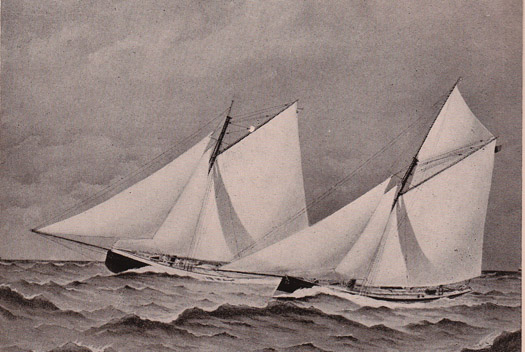
The 80-on Genesta (right) was winner of the first Round Britain and Ireland Race in 1887. She is seen here two years earlier in her unsuccessful America's Cup Challenge against Puritan
In a fleet of eleven starters, the smallest was the 40-ton cutter Sleuthhound, while the largest was the 255-ton schooner Selene. Only six of this pioneering fleet finished, and the winner was the 80-ton cutter Genesta (Sir Richard Sutton), which had unsuccessfully challenged for the America's Cup two years earlier. Inevitably, one muses on the prospects for current America's Cup challengers, successful or otherwise, in sailing this offshore course....But enough, the fact is that this was, in a sense, an early round Ireland race. And as for cruising round Ireland, that doughty cruising trailblazer R T McMullen, a Royal Thames member, had not been permitted to take part in the Golden Jubilee Race as his 16-tonner Orion was considered too small. But he sailed the course anyway as a long high-speed cruising passage, and thus in 1887 we had an early round Ireland "cruise".
So that bit of information goes into the fascination of the story of sailing round Ireland. And the more we know of the pioneering days of sailing, the more we are astonished by what some of the early cruising folk achieved when the sport was undeveloped, and the secrets and local knowledge of the remote coastlines of Ireland, the bits that were barely outlined in the official charts, were jealously guarded by people who didn't want them known. Smugglers and pirates for instance, or those who hoped to sell local knowledge on a regular basis, such as those retained as personal pilots by strangers cruising the coasts.
Then too, the development of cruising round Ireland has been much affected by the turbulent national history. Cruising and simply sailing along the coast are quintessentially activities of peace and prosperity. You need peace to cruise, and you certainly need some level of individual prosperity for the yacht owners themselves, though speaking personally a general air of prosperity ashore when you get to port is something which adds greatly to cruising enjoyment – "picturesque poverty" gives me the creeps
When we first cruised round Ireland in 1964, the western and southwestern seaboards were only just beginning to come to life after many decades of low economic activity, and it was good to see it. But it's much more enjoyable to cruise those areas these days, when – despite the recent recession – there's a lot of life about the place, and local sailing is thriving. And for those who would suggest that it's getting too crowded, I can only say you're not trying. There are many wide open spaces and secluded uncrowded anchorages if you look for them, and have a boat capable of self-sufficiency with proper anchoring arrangements which don't rely on pontoons or visitor's moorings.
But every time you do the circuit, the curiosity about who did it first from an Irish port becomes ever greater. Until the Great Famine of 1845, there had been flowerings of recreational sailing along the Atlantic coasts, with the Royal Western of Ireland Yacht Club emerging from a regatta at Kilrush on the Shannon Estuary in 1829. In an era when those who had wealth and free time had lots of it, and the entertainment industry was in its infancy, the yachts of the time were kept busy.
At its most prosperous, the Royal Western had eighteen substantial yachts based in Kilrush Creek in 1838. It's surely likely that in some seasons their delivery passages to the early regattas in Galway Bay, Belfast Lough, the Clyde, Dublin Bay and Cork Harbour inevitably became round Ireland "cruises". But as the Royal Western faded away in the horrors of the late 1840s, such things were forgotten.
The potential round Ireland sailing craft included another Shannon Estuary boat, the Knight of Glin's notably successful racer Rienvella, a 30-tonner which in 1834 was recorded as winning in both Galway Bay and at Cork. And of course the Corkmen were no slouches in racing and in cruising to races. In 1830 Caulfield Beamish of Cork turned up in Belfast Lough with his cutter Paddy (which he'd designed himself) to race against the boats of the nascent Royal Northern YC, a group which in 1838 became totally Clyde-based, though that is not necessarily attributable to the fact that the Cork boat beat them all back in 1830.

Caulfield Beamish's Paddy from Cork winning a race in hectic style in Belfast Lough in 1830.
Be that as it may, boats like Paddy and other top racers of subsequent decades in the 19th Century regularly made long passages to the main racing venues, and a west coast boat returning from events in the Irish Sea/North Channel area would naturally contemplate going northabout. But while some owners enjoyed doing these voyages, they were thought of as cranks by their peers, who expected inter-event deliveries to be done by professional crews, while the gilded owners just turned up to strut their stuff at the regattas.
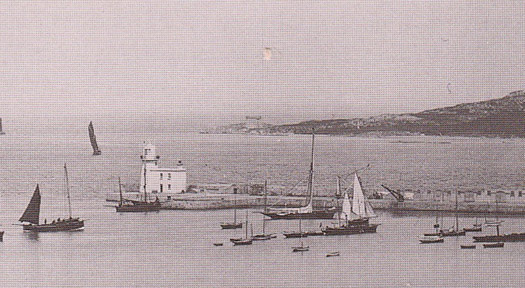
Judge Boyd's 34-ton yawl Aideen on her mooring in Howth in 1889, the year he cruised her round Ireland.
Thus it was a long time before round Ireland cruises as we recognise them today were being undertaken, and for many years the earliest proper round Ireland cruise we definitely knew of wasn't undertaken until 1889, when that great man Judge Boyd of Howth (he figures in Joyce's Ulysses) cruised round in his 34-ton 50ft yawl Aideen. And the only reason we know of it was because it was mentioned in a profile of the Judge in a Yachting Monthly of January 1910. Yet the way it was mentioned suggests that, while rare, by 1889 Round Ireland cruises were by no means a complete novelty. But how on earth to find out about earlier ones?
Enter Wally McGuirk with a Christmas present. The loan of an interesting book may strike you as a weird Christmas present, but when the lender is Wally McGuirk, it's a gem. Wally's business card says it all: "We buy and sell anything marine". He's also a certifiable innovator, and serial boat builder – his current craft, the handsome big steel cutter Swallow, is the eighth boat he has built for himself, and is doubly interesting through being the last boat designed by O'Brien Kennedy.
But that's by the way. Somehow in his mega-busy life, Wally finds time to trawl through second-hand bookshops, and in one in England he came across a facsimile printing of a jewel of early cruising which, to my shame, I'd never heard of, but we'll try to make amends now.
You may know of the Country Diary of an Edwardian Lady, a private journal of 1906 which was a runaway success when it was published in facsimile in 1977. Well, The Log of the Olivia, published in facsimile by Richmond Press in England in 1983 from the original which had come down the ages to distant relatives of the author, is cruising's equivalent to the Country Diary, except that it's even more historically significant as it dates from the period 1859 to 1867. It is the personal sailing diary, illustrated with his own skilled and charming sketches, of one William A Power, who sailed from Kingstown (now Dun Laoghaire) on Dublin Bay in his 25-ton cutter Olivia.
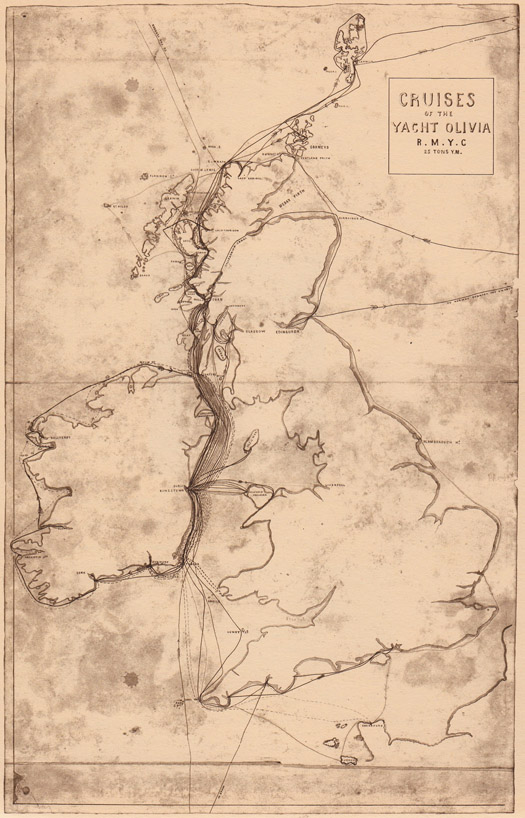
The many voyages of William Power's 25-tonner Olivia from Dublin Bay between 1859 and 1867, which included two round Ireland cruises They sailed so many times through the Irish Sea and the North Channel that they may well have worn a groove in the ocean. "RMYC" refers to Royal Mersey YC, despite the fact that Olivia was based in Dublin Bay, but Power later also listed the Royal Irish as his club.
This excellent facsimile is primarily for print connoisseurs and bibliophiles. As someone who thinks books should be devoured rather than venerated, this is strange territory for me. And equally, in our era of Google, the virtually total blank which was drawn in 1983 in filling in the background to William Power and his fine cruising yacht is almost bewildering. Yet even in 1983, a quick look at the two volume guide to Yachting, first published by the Badminton Library in 1894, would have revealed that Olivia's builder, Michael Ratsey of Cowes, was well known in sailing circles as a boatbuilder and designer, and very active through the middle decades of the 19th Century, with one of his best known racers, the cutter Myosotis, being built as late at 1877.
Thus in being the owner of Olivia, William A Power clearly knew his stuff, but whether he commissioned the boat new or bought her second hand we still don't know. At 25 tons Thames Measurement, she would have been around 45ft in overall length, for the 1860s preceded the era when TM yachts became absurdly narrow and thus unreasonably long in order to exploit the measurement rule.
We can get a very good idea of what Olivia looked at by considering the bare hull of The Nita, which was retrieved from rural seclusion in the Irish Midlands by Hal Sisk and his team in 2006. The Nita was designed and built in iron in 1868 by Bewley, Webb and Co of Dublin for the Dopping-Hepenstal family of Lough Gowna in County Longford. Despite the fact that in her long sailing life The Nita never left the waters of Lough Gowna, she was of an able seagoing shape very typical of her time, and as she too was 25 tons TM, 44ft LOA and 12ft beam, the similarities to the Olivia are remarkable.
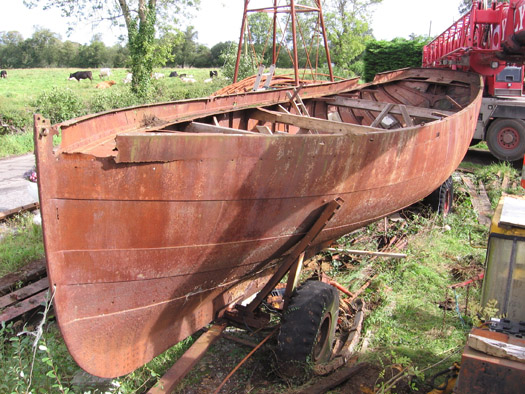
The Nita, designed and built by Bewley, Webb and Co in Dublin in 1868. In her dimensions and lines, she is remarkably similar to the Olivia. Photo: Iain McAllister
However, in every other way, the life of the wide-ranging Olivia was totally different. At the moment we know nothing of William A Power except that he was initially recorded in Hunt's Universal Register of Yachts as a member of the Royal Mersey YC (cross-channel inter-club links were strong in those days) and the Royal Western of Ireland YC, which by the 1860s had moved its base from the devastated western seaboard to Dublin Bay. Then Hunt's in 1868 records Power as being a member of the Royal Irish YC, which begins to make more sense, and also the Prince Alfred, later the Royal Alfred YC.
Writing this in the midst of the two week midwinter shutdown, we have no means of accessing membership records of any of these clubs, but it something which will be a fascinating trail to follow. As to William A Power, inevitably you'd guess he was a Power of Power's Whiskey, for the extent of his cruising suggests someone who was on an unearned income. But not an excessively generous one – by the standards of her time, the Olivia was a very modest cruising yacht, and Power cruised her with himself in command, and one or two paid hands, plus any sea-minded friends he can persuade to come along.
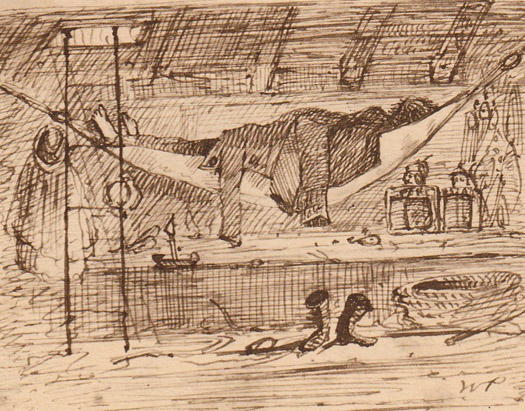
Grabbing some shut-eye in the crew's quarters during Olivia's round Ireland cruise in September 1860. While reasonably comfortable, this was no luxury yacht
Yet despite the limited resources, the cruising he did in the period 1859-1867 was simply sensational. South to Spain, east to Norway, north to the Faroes, and just about everywhere else in between. In a programme like this, in which the Olivia carved her own private roadway up and down the Irish Sea and North Channel, almost inevitably a round Ireland cruise was fitted in, but it seems to have been done in 1860 almost as an afterthought, as the Olivia had already cruised that year north to Orkney and Shetland.
It was Thursday August 30th 1860 when they sailed south from Dublin Bay, so it was a September cruise – not a month normally chosen for a round Ireland venture. And while the coasts they'd visited in the cruises of 1859 and the other cruises of 1860 had been relatively prosperous, the west coast of Ireland in 1860 was anything but.
Thus you get a feeling that the cruise was being done almost out of a sense of duty rather than in anticipation of enjoyment. And as knowledge of any special cruising attractions along the west coast had not yet been assembled in published form, by the standards of today's round Ireland cruises the experiences "enjoyed" by Olivia's crew were very thin indeed. In Cork Harbour, for example, the peak of the season was clearly well past, and up the west coast they were stuck in Cleggan for almost a week as one wet gale followed another.
After three very mixed weeks, they returned to Dublin Bay. But in due course, Power and the Olivia did another round Ireland cruise which seems to have afforded him more pleasure – that's when he did the summery sketch of the boat in Sligo Bay. In a brief initial scanning of this remarkable book, you can very quickly see where the author is enjoying himself – the word count increases and the sketches become lively, whereas when the weather is bad, you can have about four words devoted to an entire week stuck in port.
Power tells it all, including the fact he put Olivia aground on a falling tide in Achill Sound (many cruisers have done the same since), but as he carried legs they were able to keep themselves upright. To pass the time, the crew hunted down a seal that provided a very high protein diet for the rest of the voyage, which reminds us this was a very long time ago - it's surely not something a contemporary crew would contemplate.
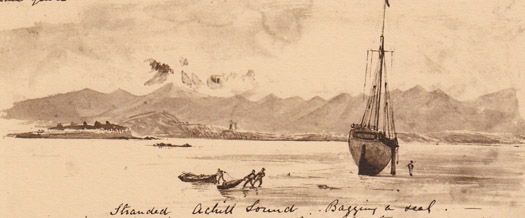
Caught out by a falling tide while straying from the channel in Achill Sound, William Power and his crew put out the legs to keep Olivia safely upright, and then bagged themselves a seal to supplement their diet for the non-stop passage the rest of the way home to Dublin Bay.
All this is just from an initial brief impression of The Log of the Olivia. It was the night before Christmas Eve when Wally appeared out of the dark with this extraordinary book. With 2014 upon us and festivities finally drawing to a close, it's clear that one of the top questions will now be: Who was William A Power? Meanwhile, a prosperous New Year to everyone.































































